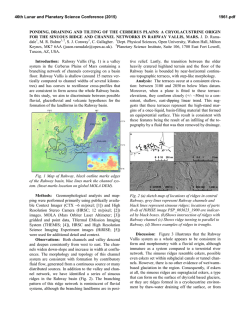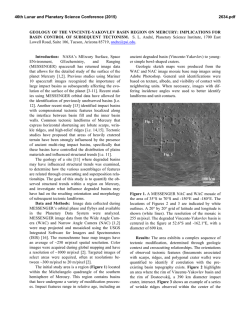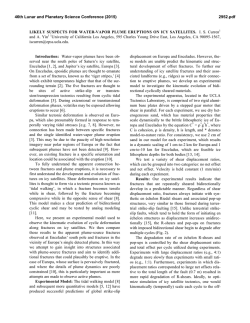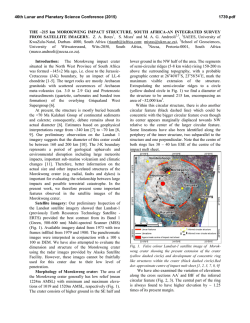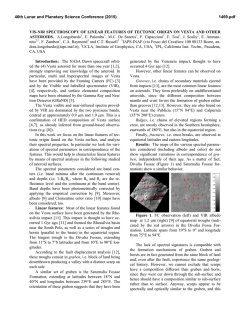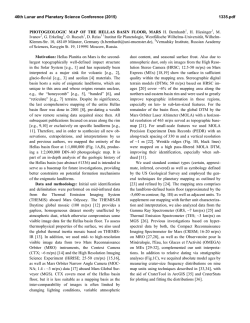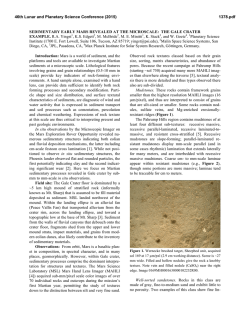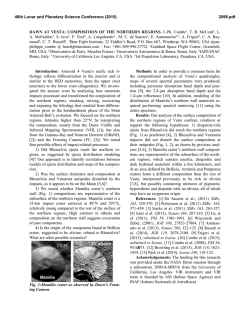
GLOBAL INVENTORY OF RECTILINEAR AND POLYGONAL RIDGE
46th Lunar and Planetary Science Conference (2015) 2148.pdf GLOBAL INVENTORY OF RECTILINEAR AND POLYGONAL RIDGE NETWORKS ON MARS. L. Kerber1, J.L. Dickson2, E.B. Grosfils3, J.W. Head2, 1Jet Propulsion Laboratory (4800 Oak Grove Dr. Pasadena, CA 91109, [email protected]), 2Department of Earth, Environmental, and Planetary Sciences, Brown University, Box 1846 Providence, RI 02912, 3Geology Department, Pomona College, 185 E. 6 th St. Claremont, CA 91711. Introduction: Rectilinear and polygonal ridge networks have been recognized in several different areas on Mars. While many types of ridges share morphological similarities, they can be created by a variety of unrelated geological processes. Here we summarize and review occurrences of rectilinear ridge networks on Mars, their morphologies, and their probable formative causes. To these we add two widespread, previously undocumented ridge occurrences located in the Medusae Fossae Formation (MFF) and Hellas Basin. Ridge Occurrences: Tharsis, Elysium, and the Highlands. Long, linear to slightly curving or en echelon (not networked) ridges have been found in a variety of locations on Mars, especially on the large Martian shields (Fig. 1a; [1-5]). These ridges can be tens of meters across and hundreds of kilometers long, and can transition from ridges into fissures along strike (white arrow). They are hypothesized to be magmatic dikes [1-5]. Inca City. A group of intersecting rectilinear ridges, informally known as “Inca City” and located within the south polar layered deposits, was observed in early Mars Orbiting Camera images and hypothesized to be either lithified duneforms, clastic dikes, or magmatic dikes (Fig. 1b; [6]). Gale Crater. Smaller networks of linear ridges (polygons ~25 m across) have been identified in Gale Crater, where they have been attributed to preferential cementation of material due to the circulation of fluids through fracture networks (Fig. 1c, black arrow indicates ridge, while white arrow indicates fracture pattern [7]). Across Mars. Transverse aeolian ridges can also form networks of intersecting bedform ridges (usually in the bottoms of craters or within other confined topography), but these occur on a scale that is orders of magnitude smaller than the other ridges described above (Fig. 1d). On Crater Floors. A network of rectilinear, crisscrossing ridges was described in several craters on the dichotomy boundary and near Nili Fossae [8-9]. These chaotic, intersecting ridges, forming irregular polygons ~1 km across, are hypothesized to be brecciated dikes emplaced during the process of crater formation [8-9]. The Medusae Fossae Formation. MFF networks consist of thin, dark, intersecting ridges of resistant material that becomes exposed as the result of the erosion of fine-grained, lighter-toned material surrounding them. The ridge thicknesses are fairly uniform, unlike the ridges attributed to cemented fractures or impactinduced clastic diking, which vary in thickness both between ridges and along strike. Figure 1. Examples of different types of rectilinear and polygonal ridges on Mars. 46th Lunar and Planetary Science Conference (2015) 2148.pdf The tops of the ridges form a generally flat surface, except at the edges of networks where the distal ends of ridges tail off. Two types of interlocking patterns are common: a generally isotropic pattern of intersecting ridges (Fig. 2a), and a curvilinear, fish-scale-like arrangement of ridges. The ridges tend to be relatively dark and erode by shedding blocky boulders, while the material that surrounds them (the MFF) is light-toned and erodes into loose, fine-grained material. Like the Gale Crater ridges, the MFF ridges are associated with fractured terrains: the two patterns of ridges mirror two different patterns of MFF fracturing that are common in ridge-forming areas (Fig. 2b). Unlike the Gale Crater ridges, however, the MFF ridges tend to be associated with lava flows. Ridges often emerge from remnant mesas of fractured MFF material where these mesas sit alongside a lava flow (Fig. 2c), and in some places a rough lava flow surface will transition directly into a ridge-covered surface (Fig. 2d). It is possible that the ridges represent the result of a lava flow entering a network of MFF fractures. If this is the case, it explains the appearance of the ridges (dark and blocky), their geometric similarity to nearby fracture networks, and their nearly uniform heights, which would correspond to the height of the lava flow at the time of emplacement. Hellas Basin. These polygonal ridge networks are widespread in the northwestern part of central Hellas Basin. They consist of thick, light-toned, intersecting ridges. Like the MFF ridges, they do not usually change thickness along strike, but the large networks can sometimes contain subsidiary networks composed of smaller ridges forming smaller polygons (Fig. 3). The Hellas ridges do not shed blocks, but appear extensively fractured. The Hellas ridges are not associated with lava flows, and are more likely to be filled with sediment. Figure 3. Ridges in Hellas Basin. ESP_028457_1425. References: [1] Shean, D.E., Head, J.W., Marchant, D.R. (2005) JGR, 110, E05001. [2] Head J.W. et al. (2006) GSA 34, 285–288. [3] Basilevsky A.T. (2006) GRL 33, L13201. [4] Pedersen G.B.M. et al. (2010) EPSL 294, 424– 439. [5] Wilson L. Mouginis-Mark P.J. Icarus 165, 242-252, 2003. [6] Malin et al. (1998) Science 279, 1681. [7] Thomson et al. (2011) Icarus 214, 413-432. [8] Head, J.W., Mustard, J.F. (2006) Meteorit. Planet. Sci. 41, 1675-1690. [9] Saper, L., Mustard, J., (2013) GRL 40, 245-249. Figure 2. Ridges in the MFF.
© Copyright 2025
